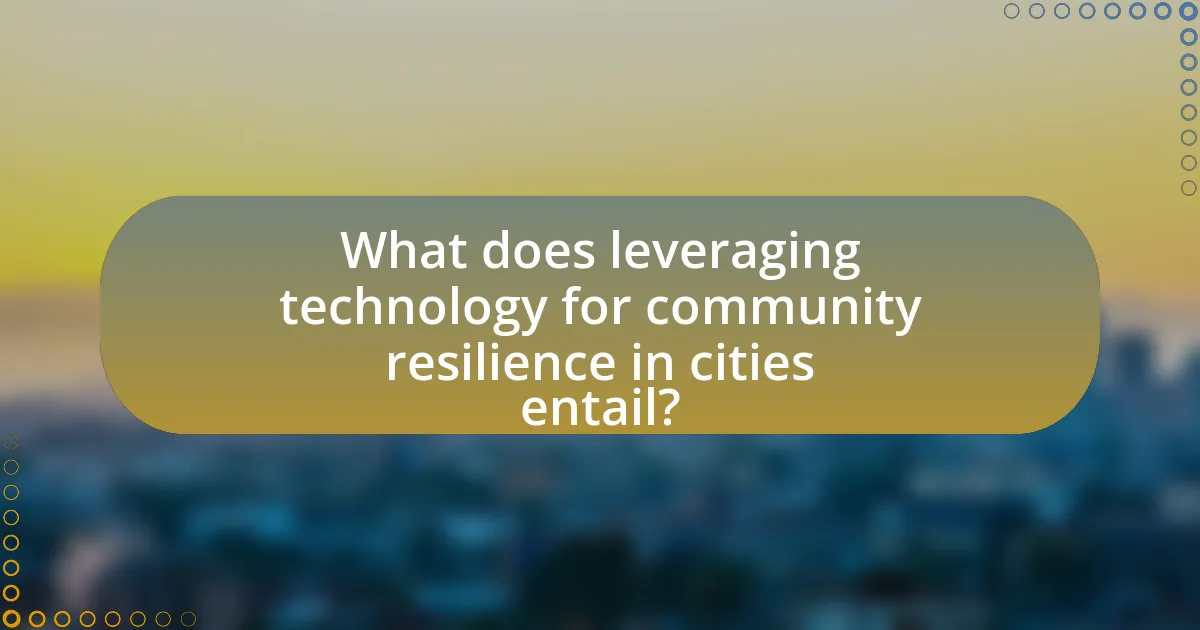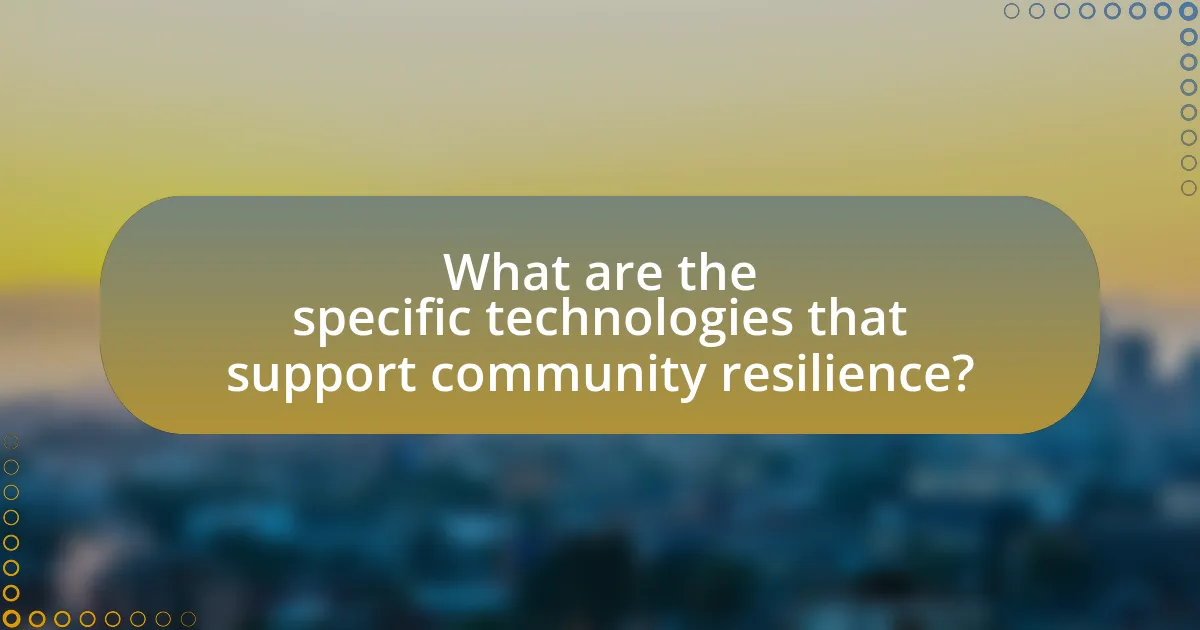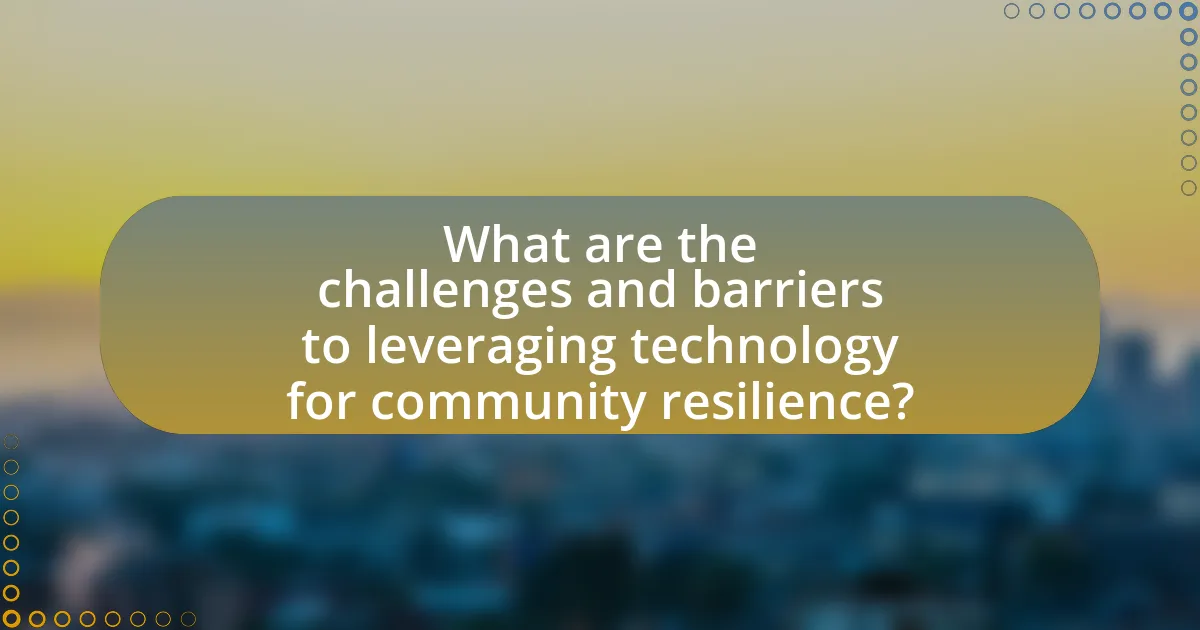Leveraging technology for community resilience in cities involves the use of digital tools and data-driven solutions to enhance urban populations’ ability to withstand and recover from challenges such as natural disasters and economic disruptions. Key technologies include data analytics, geographic information systems (GIS), mobile applications, and smart infrastructure, which collectively improve communication, resource management, and emergency response. The article explores the significance of community resilience, the challenges cities face, and the role of community engagement in technology initiatives, while also addressing privacy concerns and strategies for effective implementation. It emphasizes the importance of partnerships between public and private sectors in enhancing technology adoption and outlines practical steps for cities to develop and measure the effectiveness of technology-driven resilience plans.

What does leveraging technology for community resilience in cities entail?
Leveraging technology for community resilience in cities entails utilizing digital tools and data-driven solutions to enhance the ability of urban populations to withstand and recover from various challenges, such as natural disasters, economic shifts, and social disruptions. This approach includes the implementation of smart infrastructure, real-time data analytics, and community engagement platforms that facilitate communication and resource sharing. For instance, cities like San Francisco have adopted predictive analytics to improve emergency response times, demonstrating how technology can directly contribute to resilience by optimizing resource allocation and enhancing public safety.
How can technology enhance community resilience?
Technology enhances community resilience by providing tools for better communication, data analysis, and resource management during crises. For instance, mobile applications enable real-time information sharing among residents, which is crucial during emergencies like natural disasters. Additionally, data analytics can identify vulnerabilities within a community, allowing for targeted interventions. A study by the National Institute of Standards and Technology found that communities utilizing technology for emergency preparedness saw a 30% improvement in response times during disasters. This demonstrates that technology not only facilitates immediate communication but also strengthens overall community preparedness and recovery efforts.
What are the key technologies used in building community resilience?
Key technologies used in building community resilience include data analytics, geographic information systems (GIS), mobile applications, and social media platforms. Data analytics enables communities to assess risks and identify vulnerabilities by analyzing large datasets, which can inform decision-making processes. Geographic information systems provide spatial analysis tools that help visualize and manage resources, infrastructure, and hazards, enhancing planning and response strategies. Mobile applications facilitate communication and information sharing among community members during emergencies, while social media platforms serve as vital channels for disseminating information and fostering community engagement. These technologies collectively enhance situational awareness, improve resource allocation, and strengthen community networks, ultimately contributing to greater resilience against various challenges.
How do these technologies interact with urban infrastructure?
Technologies such as IoT, AI, and big data analytics interact with urban infrastructure by enhancing efficiency, sustainability, and responsiveness. For instance, IoT sensors monitor traffic flow and environmental conditions, allowing cities to optimize traffic management and reduce pollution levels. AI algorithms analyze data from these sensors to predict maintenance needs for infrastructure, thereby preventing costly repairs and improving service delivery. Additionally, big data analytics enables urban planners to make informed decisions based on real-time data, leading to better resource allocation and urban design. These interactions demonstrate how technology can transform urban environments into smarter, more resilient communities.
Why is community resilience important for cities?
Community resilience is crucial for cities because it enhances their ability to withstand and recover from various challenges, including natural disasters, economic downturns, and social disruptions. Resilient communities can adapt to changing conditions, ensuring continuity of essential services and maintaining social cohesion. For instance, cities that invest in community resilience strategies, such as emergency preparedness programs and local support networks, demonstrate improved recovery times and reduced economic losses during crises. Research indicates that resilient cities can save up to 20% in recovery costs compared to those that lack such strategies, highlighting the financial and social benefits of fostering resilience within urban environments.
What challenges do cities face that require resilience strategies?
Cities face challenges such as climate change, urbanization, infrastructure decay, and social inequality that require resilience strategies. Climate change leads to extreme weather events, necessitating adaptive infrastructure and emergency response systems. Rapid urbanization increases population density, straining resources and services, which demands innovative solutions for housing and transportation. Infrastructure decay results in vulnerabilities, highlighting the need for investment in maintenance and upgrades to ensure safety and functionality. Social inequality exacerbates vulnerabilities, requiring inclusive policies that address the needs of marginalized communities. These challenges underscore the importance of resilience strategies to enhance urban sustainability and community well-being.
How does community resilience impact social cohesion?
Community resilience significantly enhances social cohesion by fostering trust, collaboration, and mutual support among residents. When a community demonstrates resilience, it effectively mobilizes resources and networks to address challenges, which strengthens interpersonal relationships and collective identity. Research indicates that resilient communities are better equipped to recover from crises, leading to increased social interactions and shared experiences that bind individuals together. For instance, a study by the National Academies of Sciences, Engineering, and Medicine found that communities with strong social networks exhibit higher levels of resilience during disasters, as residents rely on each other for assistance and emotional support. This interconnectedness not only aids in immediate recovery but also cultivates long-term social bonds, reinforcing the overall fabric of the community.

What are the specific technologies that support community resilience?
Specific technologies that support community resilience include geographic information systems (GIS), early warning systems, mobile communication platforms, and renewable energy technologies. Geographic information systems enable communities to analyze spatial data for disaster preparedness and resource management, enhancing situational awareness during emergencies. Early warning systems provide timely alerts about natural disasters, allowing communities to take proactive measures. Mobile communication platforms facilitate real-time information sharing and coordination among community members and emergency services. Renewable energy technologies, such as solar panels and wind turbines, contribute to energy independence and sustainability, reducing vulnerability to energy disruptions. These technologies collectively enhance a community’s ability to withstand and recover from adverse events.
How do smart city technologies contribute to resilience?
Smart city technologies enhance resilience by enabling real-time data collection and analysis, which facilitates informed decision-making during emergencies. For instance, smart sensors monitor environmental conditions, allowing cities to respond swiftly to natural disasters like floods or heatwaves. According to a report by the World Economic Forum, cities utilizing smart technologies can reduce response times to crises by up to 30%, thereby minimizing damage and improving recovery efforts. Additionally, integrated communication systems ensure that citizens receive timely alerts and information, further strengthening community preparedness and resilience.
What role do data analytics play in enhancing urban resilience?
Data analytics play a crucial role in enhancing urban resilience by enabling cities to analyze vast amounts of data for better decision-making and resource allocation. Through predictive modeling and real-time data analysis, urban planners can identify vulnerabilities, optimize infrastructure, and improve emergency response strategies. For instance, cities like New York utilize data analytics to assess flood risks and develop adaptive measures, which has been shown to reduce potential damages by up to 30%. This data-driven approach not only enhances preparedness for natural disasters but also fosters sustainable urban development by informing policies that address climate change impacts.
How can IoT devices improve emergency response in cities?
IoT devices can significantly improve emergency response in cities by enabling real-time data collection and communication. These devices, such as smart sensors and connected cameras, provide critical information about incidents, allowing emergency services to assess situations quickly and allocate resources effectively. For instance, a study by the National Institute of Standards and Technology found that integrating IoT technology in emergency management can reduce response times by up to 30%. Additionally, IoT devices can facilitate better coordination among first responders through shared platforms, enhancing situational awareness and improving overall response efficiency.
What is the significance of community engagement in leveraging technology?
Community engagement is significant in leveraging technology as it fosters collaboration between residents and tech developers, ensuring that technological solutions address real community needs. Engaged communities can provide valuable insights that guide the development of technology, making it more relevant and effective. For instance, the National League of Cities reports that cities with active community participation in technology initiatives see improved outcomes in public services and increased trust in local government. This collaboration not only enhances the effectiveness of technology but also empowers residents, leading to greater community resilience and adaptability in urban environments.
How can technology facilitate community participation in resilience planning?
Technology can facilitate community participation in resilience planning by providing platforms for communication, data sharing, and collaborative decision-making. Digital tools such as mobile applications, social media, and online surveys enable residents to voice their concerns, share local knowledge, and contribute to planning processes in real-time. For instance, platforms like SeeClickFix allow citizens to report issues in their neighborhoods, which local governments can address promptly. Additionally, Geographic Information Systems (GIS) can visualize data related to hazards and vulnerabilities, helping communities understand risks and engage in informed discussions. Research by the National Institute of Standards and Technology highlights that technology enhances stakeholder engagement, leading to more effective and inclusive resilience strategies.
What are the best practices for involving citizens in technology initiatives?
The best practices for involving citizens in technology initiatives include fostering collaboration, ensuring transparency, and providing education. Collaboration can be achieved by engaging citizens in the design and implementation phases, allowing them to contribute their insights and needs. Transparency is crucial; sharing information about project goals, processes, and outcomes builds trust and encourages participation. Education empowers citizens by equipping them with the necessary skills to engage effectively with technology initiatives. Research indicates that cities that actively involve citizens in technology projects see increased satisfaction and better outcomes, as evidenced by the Smart Cities initiative, which emphasizes citizen engagement as a key component for success.

What are the challenges and barriers to leveraging technology for community resilience?
The challenges and barriers to leveraging technology for community resilience include limited access to technology, lack of digital literacy, and insufficient funding. Limited access to technology affects marginalized communities disproportionately, as approximately 25% of rural Americans lack broadband internet, hindering their ability to utilize digital tools for resilience. Lack of digital literacy further exacerbates this issue, with studies indicating that nearly 40% of adults in the U.S. do not possess the necessary skills to effectively use technology. Additionally, insufficient funding for technology initiatives restricts the implementation of innovative solutions, as many local governments face budget constraints, leading to a reliance on outdated systems that cannot support resilience efforts.
What technological limitations exist in urban environments?
Technological limitations in urban environments include inadequate infrastructure, limited connectivity, and data privacy concerns. Inadequate infrastructure hampers the deployment of advanced technologies such as smart grids and IoT devices, as many urban areas lack the necessary physical frameworks to support them. Limited connectivity, particularly in underserved neighborhoods, restricts access to high-speed internet, which is essential for leveraging digital solutions. Data privacy concerns arise from the collection and use of personal information by smart city technologies, leading to potential misuse and public distrust. These limitations hinder the effective implementation of technology aimed at enhancing community resilience in cities.
How do funding and resource allocation affect technology implementation?
Funding and resource allocation significantly influence technology implementation by determining the availability of financial and human resources necessary for successful deployment. Adequate funding allows for the acquisition of advanced technologies, skilled personnel, and ongoing support, which are critical for effective implementation. For instance, a study by the National Institute of Standards and Technology found that organizations with higher budgets for technology projects are 30% more likely to achieve their implementation goals compared to those with limited funding. Additionally, strategic resource allocation ensures that the right technologies are prioritized and that projects align with community needs, enhancing overall resilience in urban settings.
What are the privacy and security concerns associated with smart technologies?
Privacy and security concerns associated with smart technologies include data breaches, unauthorized surveillance, and the potential for misuse of personal information. Smart technologies often collect vast amounts of personal data, which can be vulnerable to hacking; for instance, a 2020 report by the Identity Theft Resource Center indicated that data breaches exposed over 37 billion records in the U.S. alone. Additionally, the integration of smart devices in public spaces can lead to pervasive surveillance, raising ethical questions about consent and individual privacy. The misuse of data by companies or third parties can result in identity theft or targeted manipulation, further exacerbating these concerns.
How can cities overcome these challenges?
Cities can overcome challenges by implementing smart technologies that enhance infrastructure, improve resource management, and foster community engagement. For instance, cities can utilize data analytics to optimize traffic flow, reduce energy consumption, and enhance public safety. A study by the McKinsey Global Institute found that smart city technologies could reduce urban energy consumption by up to 30% and improve public service efficiency. Additionally, cities can engage citizens through digital platforms that facilitate communication and feedback, ensuring that community needs are addressed effectively. This approach not only builds resilience but also strengthens social cohesion, making cities better equipped to handle future challenges.
What strategies can be employed to secure funding for resilience technologies?
To secure funding for resilience technologies, organizations can employ strategies such as developing strong partnerships with public and private sectors, leveraging grants and funding opportunities, and demonstrating the economic benefits of resilience investments. Partnerships with government agencies and private investors can enhance credibility and access to resources, as evidenced by the National Institute of Standards and Technology’s report highlighting successful collaborations that led to increased funding for resilience projects. Additionally, applying for grants from foundations and government programs specifically aimed at climate resilience can provide necessary financial support. Demonstrating the return on investment through case studies, such as the $1.5 billion saved in disaster recovery costs through proactive resilience measures in New York City, can further attract funding by showcasing the long-term financial benefits of investing in resilience technologies.
How can partnerships between public and private sectors enhance technology adoption?
Partnerships between public and private sectors enhance technology adoption by combining resources, expertise, and innovation to address community needs effectively. Public entities provide regulatory frameworks and funding, while private companies contribute technological advancements and operational efficiencies. For instance, the Smart Cities initiative demonstrates how collaboration can lead to the implementation of IoT solutions for urban management, improving services like traffic control and waste management. According to a report by the McKinsey Global Institute, cities that engage in public-private partnerships can accelerate technology deployment by up to 30%, showcasing the tangible benefits of such collaborations in enhancing community resilience.
What practical steps can cities take to effectively leverage technology for resilience?
Cities can effectively leverage technology for resilience by implementing smart infrastructure, utilizing data analytics for decision-making, and fostering community engagement through digital platforms. Smart infrastructure, such as sensors and IoT devices, allows cities to monitor environmental conditions and infrastructure health in real-time, enabling proactive maintenance and disaster response. Data analytics can enhance urban planning and resource allocation by analyzing patterns and predicting future needs, as evidenced by cities like Barcelona, which uses data to optimize public services. Additionally, engaging communities through digital platforms encourages citizen participation in resilience planning, as seen in initiatives like the City of Boston’s “Resilient Boston Harbor” project, which incorporates public feedback into climate adaptation strategies.
What are the key considerations for developing a technology-driven resilience plan?
Key considerations for developing a technology-driven resilience plan include assessing current technological capabilities, identifying vulnerabilities, and ensuring stakeholder engagement. Assessing current technological capabilities involves evaluating existing infrastructure and resources to determine what can be leveraged for resilience. Identifying vulnerabilities requires analyzing potential risks and threats to the community, such as natural disasters or cyber threats, to inform the plan’s focus. Ensuring stakeholder engagement is crucial, as collaboration with community members, local governments, and private sectors fosters a comprehensive approach and enhances the plan’s effectiveness. These considerations are supported by studies indicating that inclusive planning processes lead to more robust resilience strategies, as seen in the National Institute of Standards and Technology’s framework for community resilience.
How can cities measure the effectiveness of their technology initiatives in resilience?
Cities can measure the effectiveness of their technology initiatives in resilience by utilizing key performance indicators (KPIs) that assess both qualitative and quantitative outcomes. These KPIs can include metrics such as response times during emergencies, reduction in service disruptions, and community engagement levels in resilience planning. For instance, a study by the National Institute of Standards and Technology (NIST) highlights that cities implementing smart technology for disaster response saw a 30% improvement in response times, demonstrating the tangible benefits of such initiatives. Additionally, surveys and feedback mechanisms can provide insights into community perceptions of resilience efforts, further validating the effectiveness of technology initiatives.


